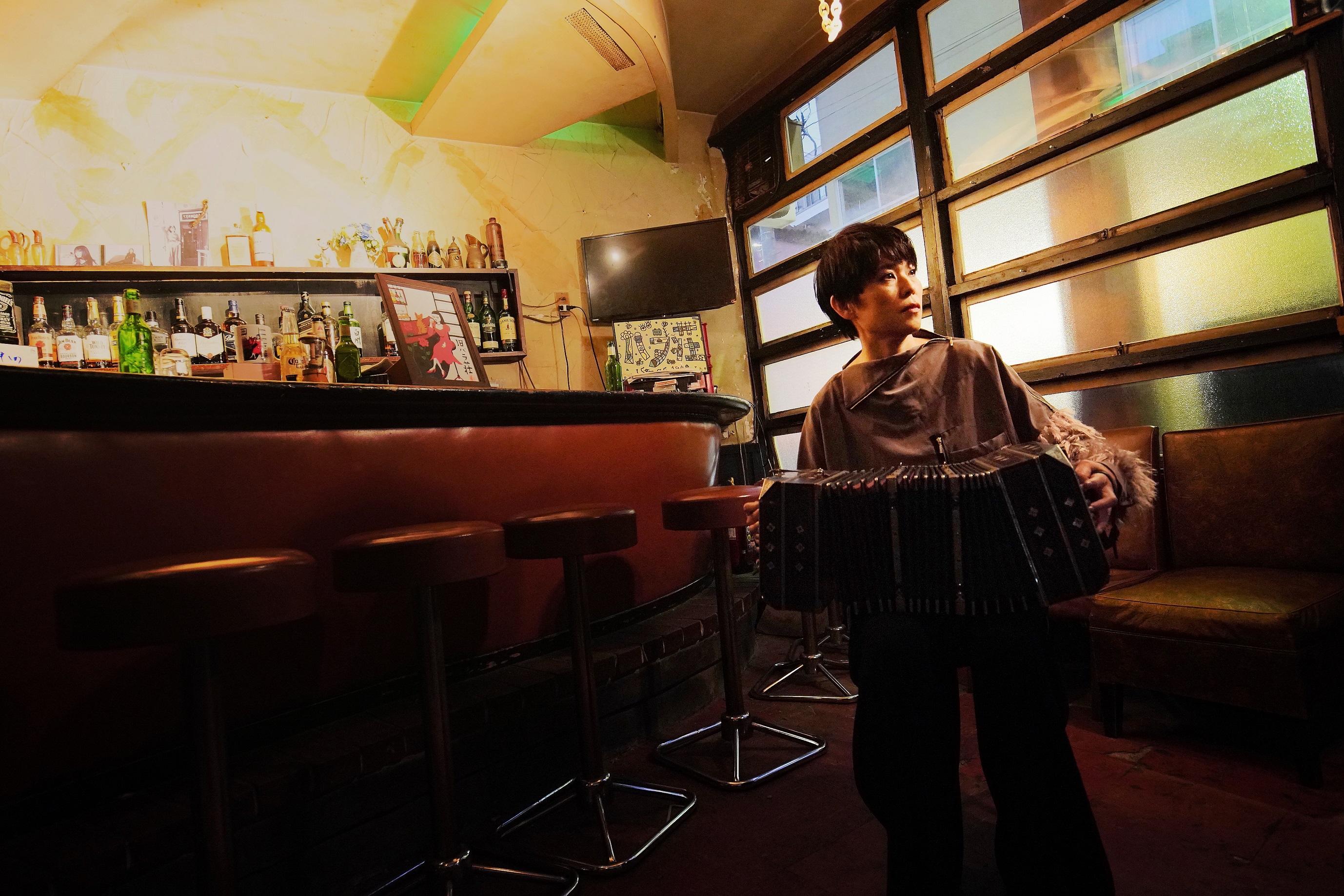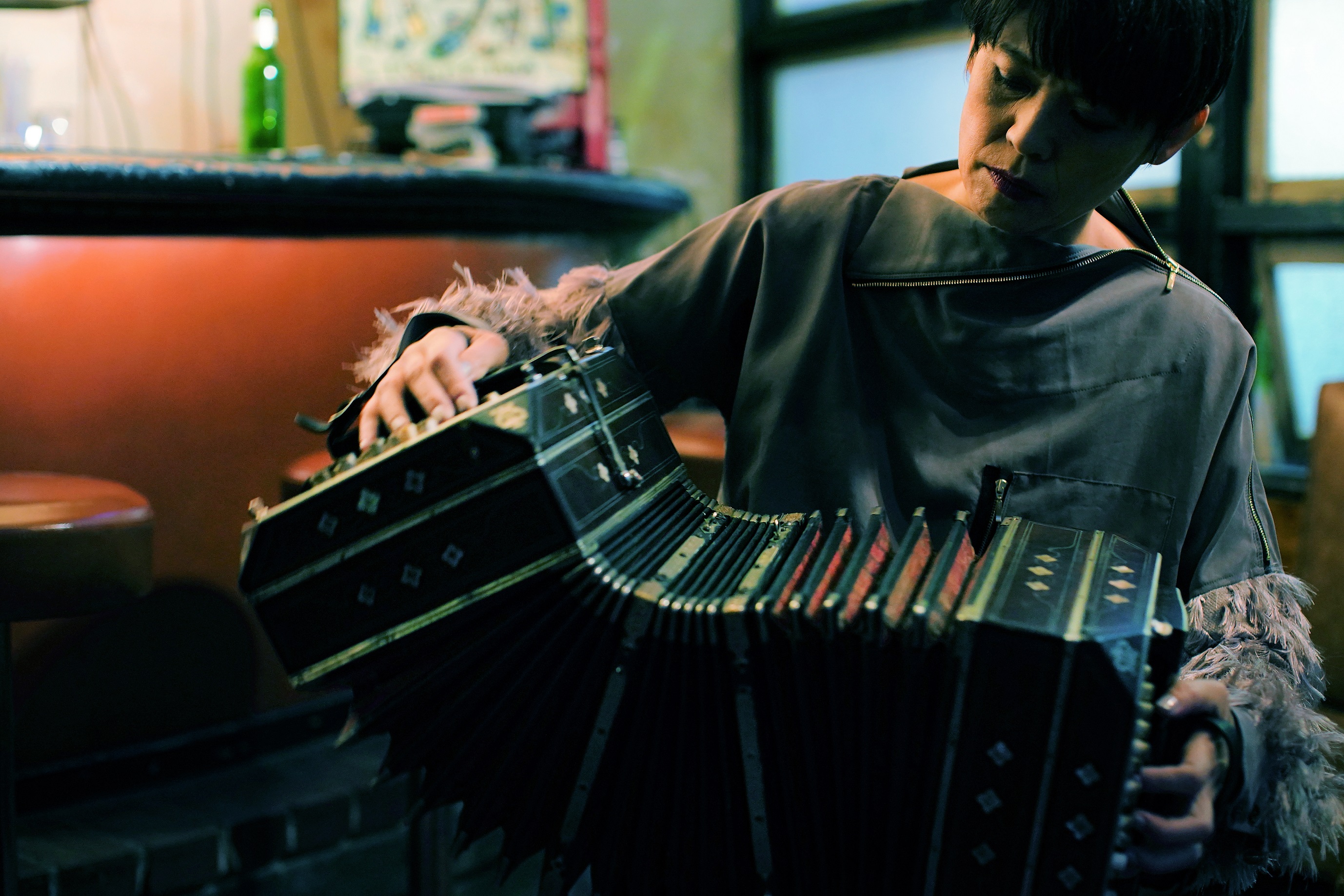お待たせしました蛇腹党インタビューVol.5、初のバンドネオン奏者インタビューは当メディア一推しのバンドネオン奏者!
大久保かおりさんです!!!!! (英訳・動画は1月10頃のUPです。)
※経歴・ライブ・活動情報及び英訳は文末にございます。(English translation is below,after the Japanese interview.)
バンドネオンという、操作もしづらい、常にメンテナンスも必要という楽器をここまで自分のものにする、楽器と大久保さんをつなげる魅力とはなんですか。初めてお会いした時に、バンドネオンの事を『ひどく面倒臭い男にはまってしまった事に似ている』と言ってましたね。それがとても印象的です。
よく聞かれます。私はもうこの楽器で演奏することが当たり前になっているので、
麻痺しているのかも知れませんが、確かに面倒くさい楽器です。訳がわからないことも多々あります。
クラッシックのオーケストラで使用される完成された楽器とくらべると曖昧なことが多い楽器です。
雑味 濁り 曖昧 不確か 不揃い 不完全これは私が表現したい世界、
私自身のモノの捉え方に共通する大切な要素です。
私が音楽で語るには、そんなバンドネオンの性格が、不可欠で程よいからかも知れません。
現象は数多い要素の重層から生まれる…そんな気がしています。
20年以上前にたまたま観た、仏映画「無伴奏シャコンヌ」の3分程の一場面でバンドネオンに遭遇し、
突然バンドネオンにのめり込んでしまったのは、不遜ながら私に似ていたからなのです。

バンドネオンといえばTANGOですが、大久保さんはあまりTANGOを演奏しないように思いますが。
先程の仏映画でメトロの通路で弾かれていたのは「リディアのワルツ」という曲でした。
タンゴではなかったのです。それまでバンドネオンの存在すら知らなかった私を唆した音です。
この楽器で表現してみたいと思うや、矢も楯もたまらず楽器を手にし先生を探しました。
私の先生はタンゴのバンドネオン奏者ですので始まりはタンゴです。
まったく覚束無い状態で先生のタンゴバンドで何年か修行をさせていただきました。
それからは自分がバンドネオンで表現したい世界を模索するなか、
ジャズミュージシャンと演奏することが多くなり、バンドに入り今に至っています。
バンドネオンを弾くにあたっては当然タンゴを聴いて勉強しました。
そのなかでタンゴの世界も少しづつ知ることになり、興味が私の中に蓄積されてはいきました。
2007年私は自身リーダーバンドをジャズミュージシャンと結成しました。
時空を旅するバンド「bando-band」(バンドネオン・コントラバス・ピアノ・パーカッション)
オリジナル曲(40曲)を中心にジャズ・ラテン・タンゴを東京のライブハウスや各地ツアーで演奏しています。
(CDリリース)メンバーは何人か入れ替わりましたが、大久保かおりが描きたい世界を音にするために、
いつでもメンバーが力を尽くしてくれます。たくさんの妄想をして、勝手に節操無く物語りを作り、
絵や記号や言葉でイメージを建築のように組み立て、それから曲を作ります。
ですからメンバーとの初めてのリハの時には譜面と解読が難しい絵や記号や言葉の譜面を渡し、
説明・解説の後に音出しになります。

私達のバンドでも初期から数曲のタンゴは演奏してきましたが、ライブではオリジナルや
他ジャンルと一緒に1曲か2曲でした。
そしてここ数年、私の中に1900年前後のブエノスアイレスを旅したいという気持ちが高まり、
タンゴの曲を作り始めたのです。
ヨーロッパから船で多くの移民がアルゼンチンに渡った頃です。まだバンドネオンがタンゴに登場していなかった時代、
そしてバンドネオンが使われ始める…。混沌とした街に、思惑を秘めた人々、場末の酒場、娼婦とのダンス…
そんな中で必然のようにバンドネオンを加えたタンゴが生まれる。
今まで作ってきた曲と同じように「物語」や「情景」を定着させて曲にします。
完成されたタンゴを演奏するというより、自分も1900年に居て楽隊に参加しているかんじです。
ここ数年バイオリンを加えタンゴだけのライブをしています。
オリジナルタンゴも含め往年のタンゴの名曲そしてピアソラも演奏しています。
新しいソロアルバムについてですが、
バンドネオンでソロ曲を演奏する方は少ないと思いますが、大久保さんにとってこのソロアルバムとは?
私はこのバンド以外にも、自身のユニットやギター、ピアノ、コントラバス、クラリネットとのデュオ、
また客演もしていますが、数年前からソロにも取り組んでいます。
もともと「場」と音で関わるコトを問題にしていましたので、生音で間近のお客さまの中でそして空間でソロを…。
アコーディオンに比べると、ソロ演奏にはかなり不向きです。私はなかなかソロを…
とはなりませんでした。
ソロアルバムは ここ数年続けてきたある意味「ソロへの挑戦」の結果です。
バンドネオンがドイツで生まれた時代に、私がいたら こんな表現をしたかも…と、
ご好意でお借りした、深夜の四谷・喫茶会記でたった一人で演奏・録音しました。
母親が子供に語りかけるように演奏したソロアルバムです。
ありがとうございました!!

撮影:大崎 聡 / ヘアメイク:鎌田 真理子 / スタイリスト:露木 藍 / Direction:蛇腹党
衣装:SHINGO KUROKAWA http://www.shingokurokawa.com/ (その他) jabara Party
撮影協力:横浜・野毛「旧バラ荘」https://www.facebook.com/nogebarbaraso
バンドネオン奏者大久保かおり 東京在住
バンドネオンでありながらタンゴにこだわらずジャズミュージシャンとの共演も多い。
1995年バンドネオンに出会い岡本昭氏に師事。
それ以前は笙(しょう)の奏者としてオリジナル曲中心に活動。
自身リーダー【音が空想する知らない時空を旅する楽隊 bando-band】は
大久保の描きたい世界を音にするバンド 結成11年目。
2017年からはviolinをゲストに迎え、TANGOに取り組んでいる。
物語を紡ぐような、絵本の中に入るような…大久保かおりの世界。
bando-bandの活動を進める一方でソロやデュオでも
いろいろな建物、場、と音で関わることに取り組んでいる。
2009年 全オリジナル9曲入CD「bando-band 1st」リリース。
2018年7月末、初のソロアルバム発売。
イラストレーターでもある
LIVE情報
詳細→ http://www.kaoneon.com

Q: You have incredible mastery over the bandoneon—an instrument that is difficult to play and requires constant maintenance. What is it about the bandoneon that you find so compelling? I was struck by your remark when we first met that it was like falling madly in love with a complicated guy.
Okubo: People often ask me the same question. I’ve probably become immune to the difficulties, because playing the bandoneon is simply what I do, but there’s no doubt that it is a high-maintenance instrument. It has many ambiguities unlike instruments played in classical orchestras, which are “finished.” But the bandoneon’s rough edges, murkiness, ambiguities, uncertainties, and incompleteness are important elements of the world that I wish to express, and the way I experience life. Perhaps these aspects of the bandoneon are essential and just right for me to communicate through music.
I feel that phenomena are produced by multiple layers of elements. I discovered the bandoneon in a French movie that I watched more than 20 years ago, called Le Joueur de Violon. It appeared in a three-minute scene, that was all, but suddenly I was hooked because, dare I say, we were so alike.
Q: Most people associate bandoneon with tango, but my impression is that you don’t perform tango very often.
Okubo: The song that the bandoneon was playing in the movie in a Paris Metro subway was a song called Lydia’s Waltz, which is not a tango. This was the sound that drew me in, although I had no knowledge of the instrument until then. I knew straight away that this was what I wanted to play. I found an instrument and looked for a teacher. My teacher was a tango bandoneon player, so I started out learning tango. For several years, I trained with his tango band without much understanding of what I was doing. After that, I started to explore what I wanted to express with the instrument and found that I was often playing with jazz musicians. Eventually I joined a band that I still perform with. Of course, I listened extensively to tango music when I was learning to play and perform. As I began to know more about the world of tango, I gradually became more interested in it.
In 2007, I formed a band with jazz musicians called bando-band (“a band that travels through time and space”) consisting of bandoneon, double bass, piano, and percussion. We perform at live music venues in Tokyo that focus on jazz, Latin, and tango music and tour all over Japan with a repertoire of around 40 original songs. There has been some change in members recording songs in the CD, but everyone always gives more than 100% to express Kaori Okubo’s world in music. I give my imagination free rein, create stories without restraint, use pictures, symbols, and words like building blocks, and then write the songs. When I first get together for rehearsals with band members, I give them sheet music and a manuscript full of mysterious pictures, symbols, and words, and have to explain it all before we can start playing.
The band played several tango pieces from its early days, but usually just one or two in a live performance with other genres. In the past few years, however, I’ve felt the urge to travel in Buenos Aires of the early 20th century. As a result, I began to compose tangos.
Around the turn of the 20th century, many immigrants from Europe arrived in Buenos Aires by boat. The bandoneon was yet to become established as tango instrument, but it was beginning to be used. Imagine crowds of people congregating in the unruly city, each with his or her hidden expectations and intentions, and men dancing with prostitutes in seedy bars. This was the social context in which tango with the bandoneon was born, as if it were meant to happen. Like all my compositions, I settle on the story and context first. It’s more like taking part in a tango band of the early 1900s myself rather than performing a complete tango piece.
In the past few years, I have performed tango in a duo with violin. I perform my own original tangos as well as well-known classical tangos and songs by Astor Piazzolla.
Q: Please tell us about your new solo album. Not many artists perform bandoneon solo pieces. What does this album mean to you?
Okubo: As well as bando-band, I perform with my own Band , in duos with guitar, piano, double bass, and clarinet, and do guest performances. I’ve also started to perform solos in the last few years. As an artist who focuses on location, I value performing live in an intimate space close to the audience. Compared with the accordion, the bandoneon is less suited to solo performance. For many years I was reluctant to play solos. This album is the result of several years of challenging myself to play solos.
If I had lived at the time when the bandoneon was invented in Germany, maybe I would have played like this…with this concept, I performed and recorded all alone late at night at [ Kissa Sakaiki ](喫茶会記) in Yotsuya courtesy of the owner. I played music for the album like a mother speaking to her child.
Kaori Okubo, bandoneon player
Okubo lives in Tokyo. Although she plays the bandoneon, she does not limit herself to tango and often performs with jazz musicians.
A former player of the Japanese classical instrument sho, mainly performing original pieces, Okubo came across the bandoneon in 1995 and became a student of Akira Okamoto. She is the leader of bando-band (“a musical ensemble that travels across unknown imaginary time and space of sound”), whose mission is to make music that expresses her vision. The band is in its 11th year. The group welcomed a guest violinist in 2017 and has started to perform tango music. Okubo’s performances tell a story, inviting the audience into a picture book-like world.
Okubo also performs solo and in duos, making music in various buildings and locations. The album bando-band 1st, which contains nine original songs, was released in 2009, and her first solo album at the end of July 2018. Okubo is also an illustrator.





